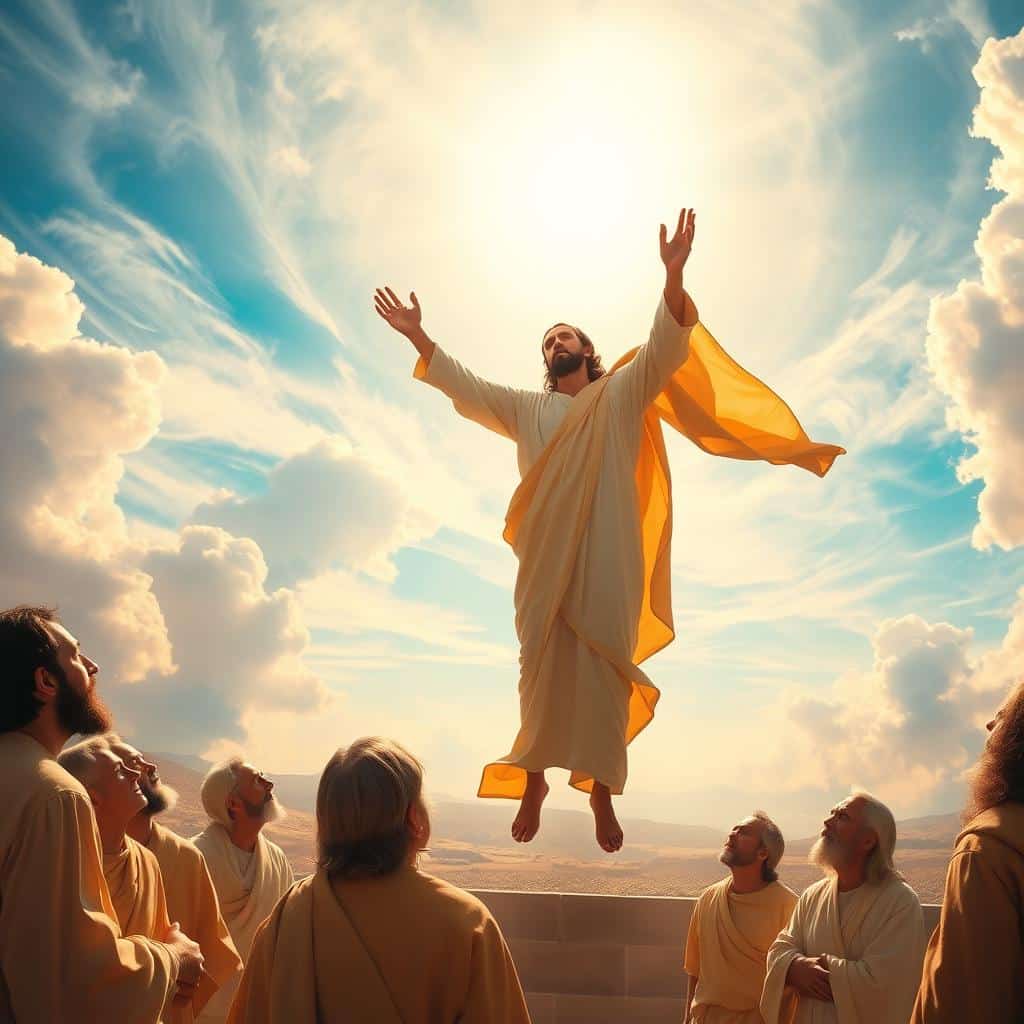The Ascension of the Lord is a key feast in the Catholic Church. It remembers Jesus Christ‘s journey to heaven after He came back to life.
In Cycle C of the Catholic Church’s calendar, the readings for this day are special. They show why Jesus’ going back to heaven is important. The first reading, from Acts 1:1-11, tells us about the event. The Responsorial Psalm, Psalm 47:2-3, 6-7, 8-9, shares the joy and respect felt then.
This feast day celebrates the end of Jesus’ work on earth. It’s a moment that shows the importance of Jesus Christ and the early Christian community.
The Significance of the Ascension in Christian Faith
The Ascension is a key part of Christian belief. It shows Jesus’ mission on earth ended and He was taken up to God’s right hand. This event is both a historical fact and a deep theological truth that gives believers hope.
Historical Context of the Ascension
The Ascension of Jesus is deeply rooted in the biblical narrative, particularly in the accounts of Luke and Acts. It marks the end of Jesus’ post-resurrection appearances and the beginning of the Church’s mission. Understanding the historical context of the Ascension is crucial for grasping its significance in Christian faith.
Theological Meaning of Christ’s Return to Heaven
The Ascension holds profound theological meaning, emphasizing Jesus’ return to heaven and His role as intercessor for humanity. This event is closely tied to the concept of salvation and the promise of future glory for believers.
The Completion of Christ’s Earthly Mission
Jesus’ ascension signifies the completion of His earthly mission, highlighting His obedience to the Father and the fulfillment of Old Testament prophecies. It marks a significant transition from His earthly ministry to His heavenly intercession.
The Promise of Our Future Glory
The Ascension gives hope that we too will be with Christ in heaven. As the second reading from Hebrews speaks of Jesus entering heaven to appear before God for us, it underscores the promise of our future glory and the intimate connection between Christ’s ascension and our own heavenly destiny.
Understanding the Liturgical Cycle C
The Catholic Church divides the year into three cycles of readings. Cycle C is special because it explores the Gospel of Luke. This cycle is part of the Church’s rich tradition, aimed at deepening our faith through scripture.
The Three-Year Cycle of Readings
The Church has a three-year cycle of readings: Cycle A, B, and C. Each cycle focuses on a different Gospel. Cycle C is special because it dives into the Gospel of Luke, offering a unique view of Jesus’ life and teachings.
Distinctive Features of Cycle C
Cycle C stands out in several ways. Two key features are:
Luke’s Gospel Emphasis
Luke’s Gospel focuses on Jesus’ mercy and compassion. During Cycle C, we see Jesus’ teachings on love, forgiveness, and God’s kingdom for all.
Themes of Mercy and Universality
Luke’s Gospel also talks about salvation for everyone. This is shown in parables like the Good Samaritan, highlighting God’s love for all people.
| Feature | Description |
|---|---|
| Gospel Emphasis | Luke’s Gospel, highlighting Jesus’ mercy and compassion |
| Themes | Mercy, universality, and the inclusivity of God’s kingdom |
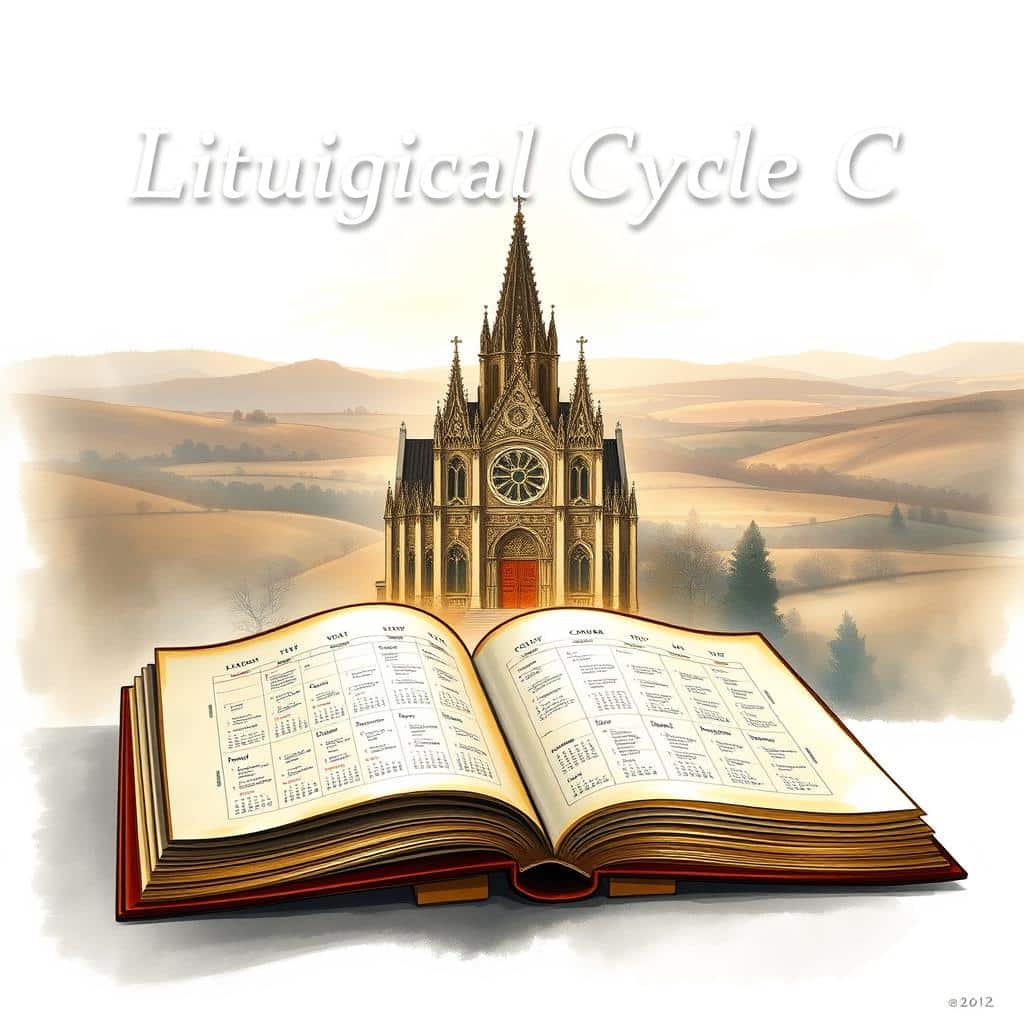
Understanding Cycle C helps us get more out of the liturgical celebration. It lets us explore the gospel readings and their importance for our faith.
Reading I: Acts1:1-11 – Christ’s Final Instructions
In Acts 1:1-11, we learn about Christ’s last words to the apostles before He ascended. This part is key to understanding the Ascension’s role in Christian faith. It also shows the mission given to the disciples.
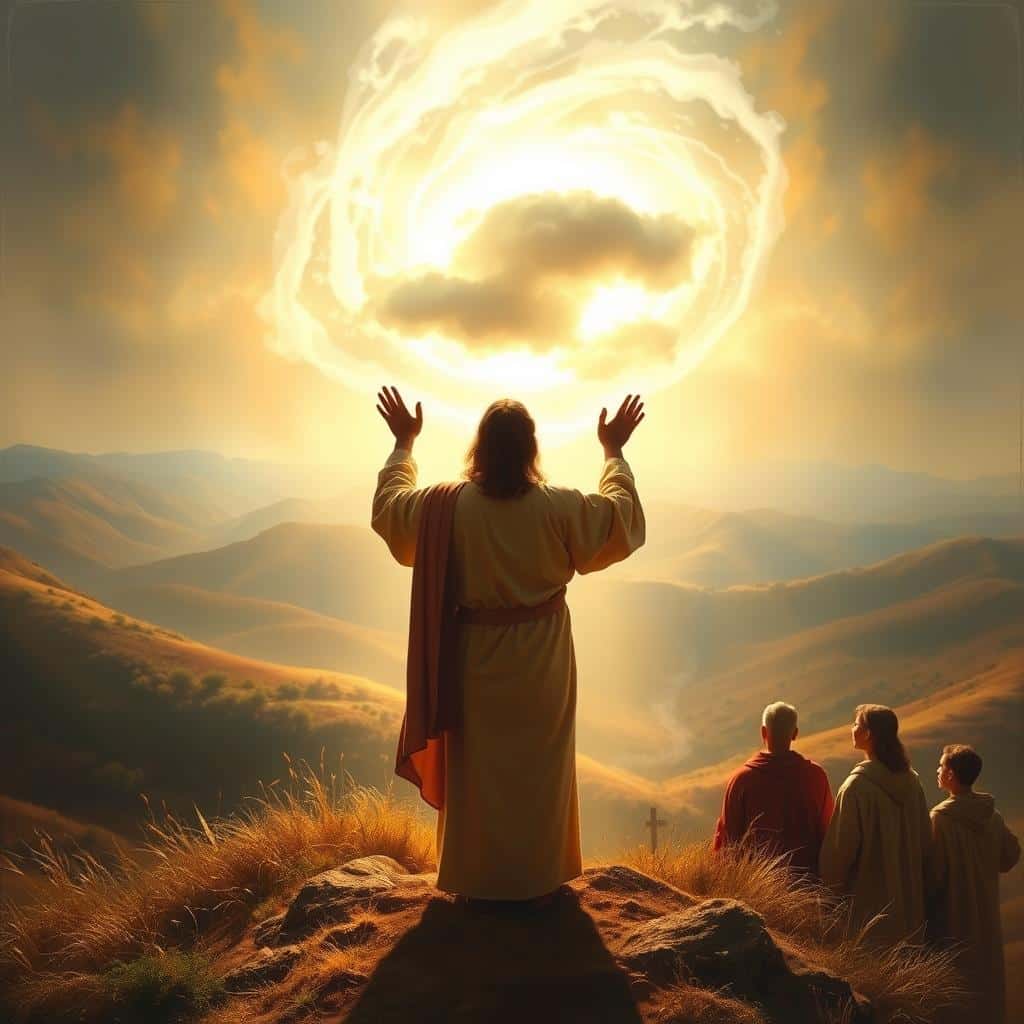
Analysis of Luke’s Account in Acts
Luke’s account in Acts 1:1-11 smoothly continues his Gospel. It highlights the Ascension’s importance. The story starts by linking back to Luke’s previous work, showing Jesus’ commands to the apostles through the Holy Spirit (Acts 1:2).
Then, it moves to Jesus’ final words. He tells the apostles to wait in Jerusalem for the Holy Spirit (Acts 1:4-5). This is crucial, linking the Ascension to the Pentecost event. It shows the Holy Spirit’s role in empowering the disciples for their mission.
The Promise of the Holy Spirit
The Holy Spirit’s promise is central in Acts 1:1-11. Jesus tells the apostles to wait for the Spirit. This Spirit will empower them to be His witnesses everywhere (Acts 1:8).
The Holy Spirit’s outpouring at Pentecost fulfills this promise. It starts the Church’s mission and spreads Christianity beyond Jerusalem.
The Apostles as Witnesses
The apostles are called to witness to Jesus Christ. This includes sharing about His life, death, resurrection, and ascension. The Ascension is key because it shows Jesus is now at God’s right hand, making Him Lord and Christ (Acts 2:33-36).
Geographic Expansion of the Gospel
The apostles’ mission goes beyond Jerusalem, reaching “the ends of the earth” (Acts 1:8). This expansion is a key part of the Christian mission. It reflects Jesus’ command to make disciples of all nations (Matthew 28:19).
The Ascension marks the start of the Church’s mission to the world. It shows the shift from Jesus’ physical presence to His spiritual presence through the Holy Spirit. This empowers the disciples to fulfill their witness.
Theological Insights from Acts1:1-11
Acts 1:1-11 offers deep insights into the Ascension mystery. It’s key to understanding Jesus’ move from earthly ministry to the apostolic mission.
The Forty Days of Instruction
Jesus taught His disciples for forty days after rising. This time was crucial for preparing the apostles for their roles. The number forty is significant in the Bible, often meaning a time of preparation or testing.
The Kingdom of God Theme
The Kingdom of God was a major focus during these forty days. It shows God’s reign in believers’ lives and the world. This theme is essential for grasping the Christian mission and the apostles’ witness.
The Cloud as Divine Presence
The cloud that took Jesus up is a sign of divine presence, like in the Old Testament. It highlights Christ’s divine ascension.
Biblical Symbolism of Clouds in Divine Encounters
Clouds in the Bible mean God’s presence or action. They guided the Israelites and overshadowed the tabernacle. In Acts 1:1-11, the cloud shows Christ’s divine journey to heaven.
| Biblical Event | Cloud Symbolism |
|---|---|
| Exodus: Israelites’ Journey | Guidance and Presence |
| Tabernacle | Divine Dwelling |
| Acts 1:1-11: Ascension | Divine Accompaniment |
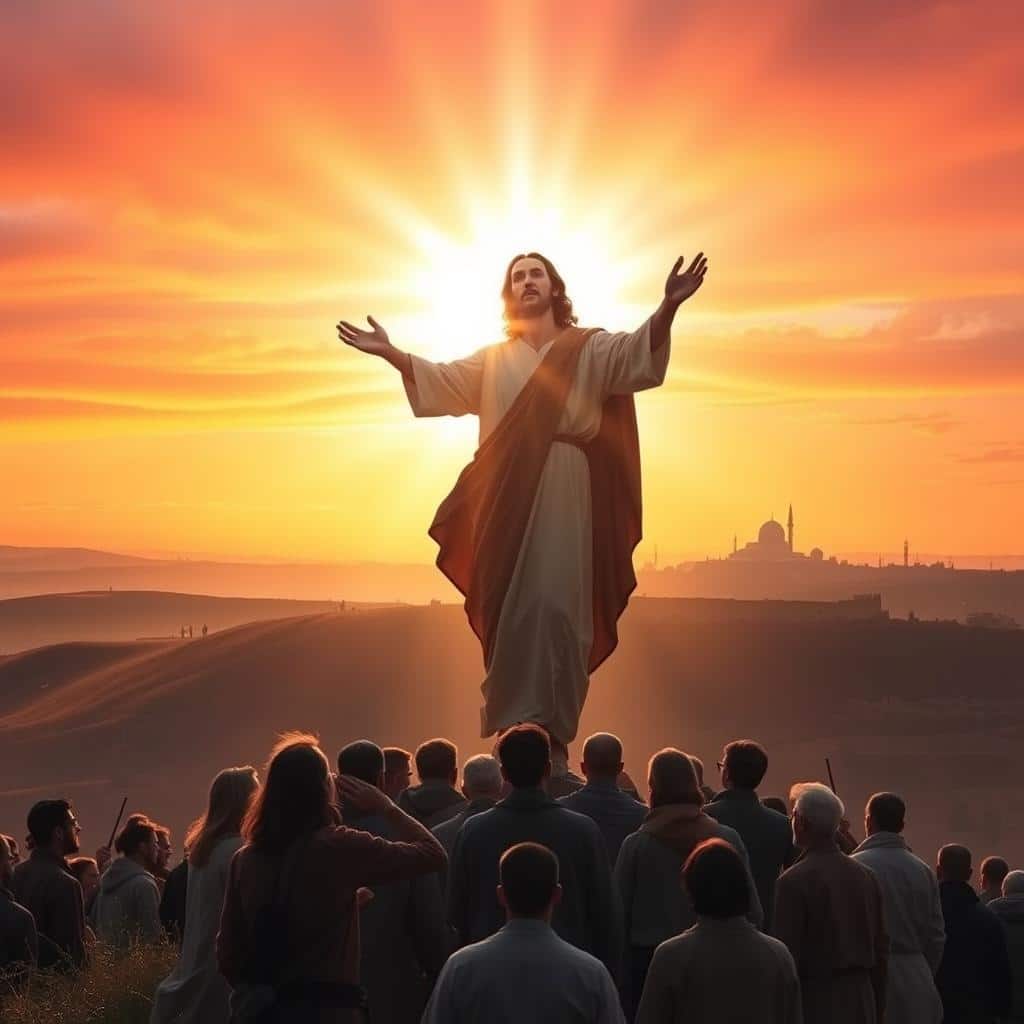
Responsorial Psalm47:2-3,6-7,8-9
On the feast of the Ascension, the Church prays through Psalm 47. It’s a joyful celebration of God’s rule over all. This Psalm captures the spirit of Christ’s Ascension perfectly.
The Imagery of God’s Kingship
Psalm 47 paints a picture of God’s kingship with vivid words. It urges all nations to “clap your hands, shout to God with cries of gladness” (Ps 47:2). This shows the joy and recognition of God’s rule.

Connection to the Ascension Theme
The Psalm’s theme of God’s kingship ties closely to the Ascension. Christ is seen as exalted to the right hand of God. This shows His victory and rule over all.
Musical Traditions for This Psalm
The music for Psalm 47 varies in the Catholic Church. Some use traditional chant, while others prefer modern songs.
| Liturgical Tradition | Musical Setting |
|---|---|
| Traditional | Gregorian Chant |
| Contemporary | Modern Hymns |
Different musical traditions make Psalm 47 a lively part of the Ascension feast.
Reading II: Ephesians1:17-23 – Christ Exalted
The passage from Ephesians 1:17-23 gives us a deep look into Paul’s prayer. He prays for spiritual wisdom and the revelation of Christ’s supremacy. This scripture is key to understanding Christ’s ascension and exaltation.
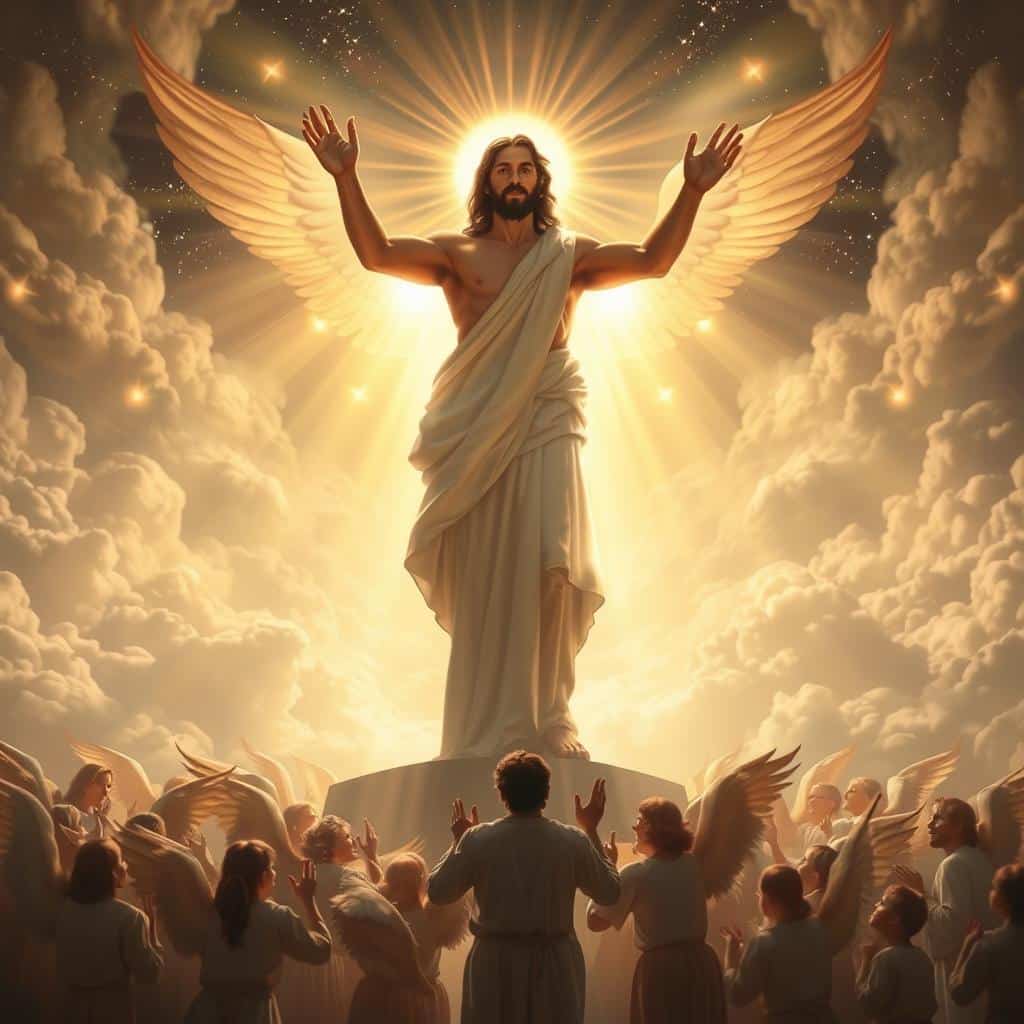
Paul’s Prayer for Spiritual Wisdom
Paul asks for the Ephesians to have wisdom and revelation in Christ. He wants their hearts to be enlightened. This shows the importance of spiritual understanding and our calling.
The Power of God in Raising Christ
The power of God that raised Christ is a major theme in Ephesians 1:17-23. This power is not just for the past but works in believers today. It shows the greatness of God’s might in Christ’s resurrection and ascension.
Christ’s Supremacy Over All Creation
Christ is exalted and sits at God’s right hand in heaven. He is above all power and dominion. This has big implications for our faith and how we live.
Implications for Christian Authority and Leadership
Christ’s supremacy affects Christian leadership and authority. It calls for leaders who serve like Christ. They should empower believers with the Holy Spirit.
In conclusion, Ephesians 1:17-23 gives us a deep understanding of Christ’s exaltation. It shows its importance for our lives and leadership. It encourages us to seek wisdom and recognize Christ’s power and supremacy.
Theological Dimensions of Ephesians1:17-23
Ephesians 1:17-23 shows us the deep meaning of Christ’s rule in the Church. This part of the Bible, read on the Solemnity of the Ascension, dives into the big picture of Christ’s rise.
The Cosmic Significance of Christ’s Lordship
The Apostle Paul’s prayer in Ephesians 1:17-23 talks about the cosmic significance of Christ’s rule. Paul asks the Father to give the Ephesians wisdom and insight into Christ. This wisdom is not just about knowing things but understanding Christ’s victory over all.
The passage says God has made Christ greater than any power or name. This shows Christ’s rule over everything in the universe.

The Church as Christ’s Body
Paul also says Christ is the head of the Church, his body. This shows a close bond between Christ and the Church. The Church is more than just people; it’s a part of Christ.
This idea shapes how the Church sees its purpose and who it is.
Unity and Diversity in the Body of Christ
The Church as Christ’s body also talks about unity and diversity. Just like a body has different parts working together, the Church is diverse yet united in Christ. This unity is not about being the same but about working together for the greater good.
Paul says there are many gifts and services, but they all come from the same Spirit and Lord. This shows the value of everyone’s role in the Church.
In summary, Ephesians 1:17-23 gives us a deep look at the Ascension. It teaches us about Christ’s rule over all and our place in the Church. It encourages us to celebrate both our unity and diversity as Christ’s body.
Gospel: Luke24:46-53 – The Ascension Narrative
Reflecting on Luke 24:46-53, we see Jesus’ last moments with His disciples. It shows how God’s plan was fulfilled through Christ’s suffering, resurrection, and the call to repentance.
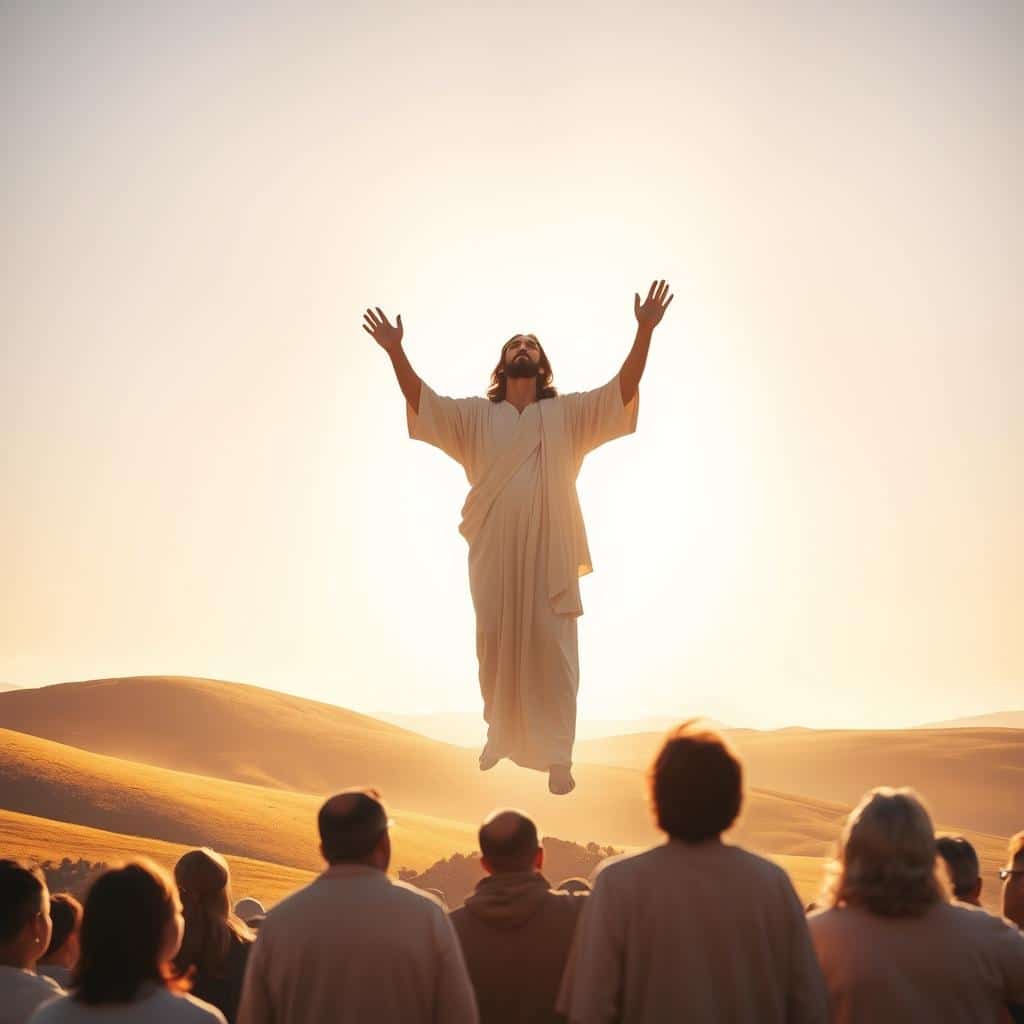
Christ’s Final Teaching
In Luke 24:46-47, Jesus teaches about the importance of His suffering and resurrection. This teaching links the Old Testament prophecies to Jesus Christ.
The Commission to the Disciples
The disciples are told to be witnesses and wait for the Holy Spirit in Luke 24:48-49. This is a key moment, as it shifts responsibility from Jesus to His followers. They are tasked with sharing the message of repentance and forgiveness.
The Blessing and Departure
In Luke 24:50-53, Jesus blesses and ascends. The blessing shows divine favor and protection to the disciples. Jesus’ ascension marks a moment of both leaving and staying, as He is taken up into heaven but remains with His followers in spirit.
The Disciples’ Response of Joy and Worship
The disciples are filled with joy after Jesus ascends. They return to Jerusalem, ready to receive the Holy Spirit. Their worship in the temple shows their newfound understanding of Jesus’ mission.
This Gospel reading captures the essence of the Ascension. It highlights the disciples’ role as witnesses and the importance of Jesus’ return to heaven. It encourages readers to reflect on their faith and the call to spread the Gospel message.
Solemnity of the Ascension of the Lord, Cycle C: Complete Liturgical Context
The Ascension is a joyous and reflective moment in the Easter season. It celebrates the end of Christ’s earthly life and his return to God the Father.

Placement in the Easter Season
The Ascension is celebrated on a Thursday, but in the U.S., it’s often on a Sunday. This shows the link between Christ’s resurrection and ascension, emphasizing his ongoing mission.
The Easter season lasts fifty days, starting on Easter Sunday and ending on Pentecost Sunday. The Ascension, on the 40th day after Easter, is a key moment. It looks forward to the Holy Spirit’s arrival.
Relationship to Pentecost
The Ascension and Pentecost are closely tied in the calendar. The Ascension celebrates Christ’s victory and his return to the Father. Pentecost, on the other hand, remembers the Holy Spirit’s coming, empowering the disciples.
“When the day of Pentecost came, they were all together in one place. And suddenly there came a sound from heaven as of a rushing mighty wind, and it filled all the house where they were sitting.” (Acts 2:1-2)
Liturgical Colors and Symbols
The color for the Ascension is white, symbolizing joy and triumph. The liturgy includes symbols like incense, representing prayers rising to heaven, just like Christ’s ascension.
Special Rituals and Practices
Dioceses and parishes have unique rituals for the Ascension. These can include veneration of the cross, special music, and processions. These traditions vary, showing local customs and community culture.
In conclusion, the Solemnity of the Ascension of the Lord is a key feast in the Easter season. It encourages us to think about Christ’s return to heaven and the promise of his second coming.
Celebrating the Ascension: Traditions and Customs
The feast of the Ascension is filled with history and tradition. It shows how different cultures and Christian groups celebrate this event. This important day in the Christian calendar celebrates Jesus Christ’s ascension into heaven.
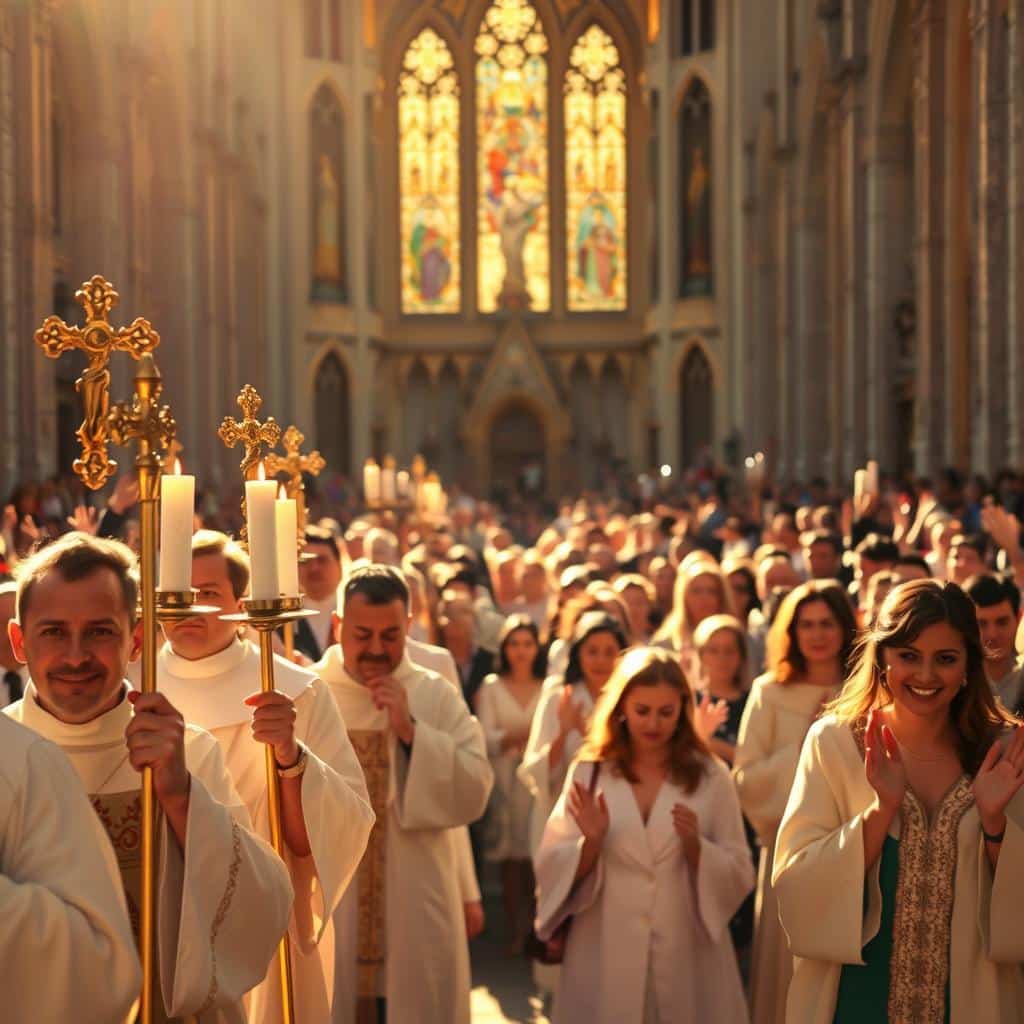
Historical Observances
For a long time, the Ascension was celebrated on a Thursday. This day, known as Ascension Thursday, is a key feast in the Christian calendar.
Contemporary Practices in the United States
In the United States, some Catholic dioceses still celebrate the Ascension on Thursday. But many have moved it to the following Sunday. This change shows the variety in American Catholic practices.
Ascension Thursday vs. Sunday Observance
Choosing to celebrate the Ascension on Thursday or Sunday changes how it’s observed. Thursday keeps the traditional day, while Sunday lets more people join in.
Regional Variations in American Catholic Dioceses
Across the United States, different dioceses have their own ways of celebrating the Ascension. Here’s a look at some of these differences:
| Diocese | Observance Day | Notable Traditions |
|---|---|---|
| New York | Sunday | Special Masses, Processions |
| Los Angeles | Thursday | Liturgical Celebrations, Community Events |
| Chicago | Sunday | Family-oriented Activities, Educational Programs |
The variety in celebrating the Ascension shows the rich Catholic traditions in the United States. It highlights the feast’s importance in the Christian calendar.
Homiletic Themes for the Ascension
The Ascension of Jesus Christ is a key moment in Christian faith. It highlights the church’s mission and Jesus’ promise to return. This feast encourages us to think about our role as witnesses to the risen Lord.
Mission and Witness
The story in Acts 1:1-11 shows the value of witnessing Christ’s life, death, and resurrection. As Jesus goes up, He tells His followers to share the Gospel with everyone. This mission is still ours today.
The Promise of Return
The angels tell the disciples, “This Jesus, who has been taken up from you into heaven, will come back in the same way you have seen Him go into heaven” (Acts 1:11). This reminds us of Jesus’ promise to return. This hope helps us stay strong in our mission.
Living Between Ascension and Parousia
We are living between the Ascension and Jesus’ Second Coming. This time is filled with tension. We see the ‘already’ of Christ’s victory and the ‘not yet’ of its full realization. This tension urges us to stay alert and faithful.
Addressing Modern Challenges Through Ascension Themes
In today’s world, the Ascension themes guide us. They urge us to be active witnesses, hold onto the hope of Christ’s return, and live with the confidence of His ultimate victory.

By embracing these themes, we can deepen our faith and our role in the world. We are inspired to live out our calling with renewed purpose.
Prayers and Devotions for the Ascension
The Ascension feast is a big moment in our faith calendar. It invites us to grow closer to God through prayer and devotion.
Catholics use this time to think deeply about their faith. They also try to improve their prayer and devotion. It’s a chance to honor Christ’s ascension.
Traditional Ascension Prayers
Prayers for the Ascension focus on Christ’s glory and our hope to join Him. Here’s one example:
“Almighty and eternal God, you have raised our Savior, Jesus Christ, to the heavens and established him as our high priest. Grant that, as we celebrate this feast, we may be drawn closer to you and share in the glory of your Son, our Lord Jesus Christ.”
Novena to the Holy Spirit
The novena to the Holy Spirit is a big part of the Ascension season. It’s nine days of prayer and asking for the Holy Spirit’s help.
Family Prayer Activities for the Ascension
Families can celebrate the Ascension with prayer together. Here are some ideas:
- Make a prayer corner with Ascension pictures and prayers.
- Do the novena to the Holy Spirit as a family.
- Think about Scripture readings about the Ascension.

Artistic Representations of the Ascension
The Ascension of Jesus Christ has been a key theme in Christian art for centuries. This event, marking the end of Christ’s earthly life, has inspired many artists. They have created works that show its deep meaning.
Classical Iconography
In classical Christian art, the Ascension is depicted with certain symbols. Christ is shown going up into a cloud, sometimes with angels or disciples below. The clouds symbolize the divine presence and the heavenly realm. This comes from biblical texts, like Acts 1:9.
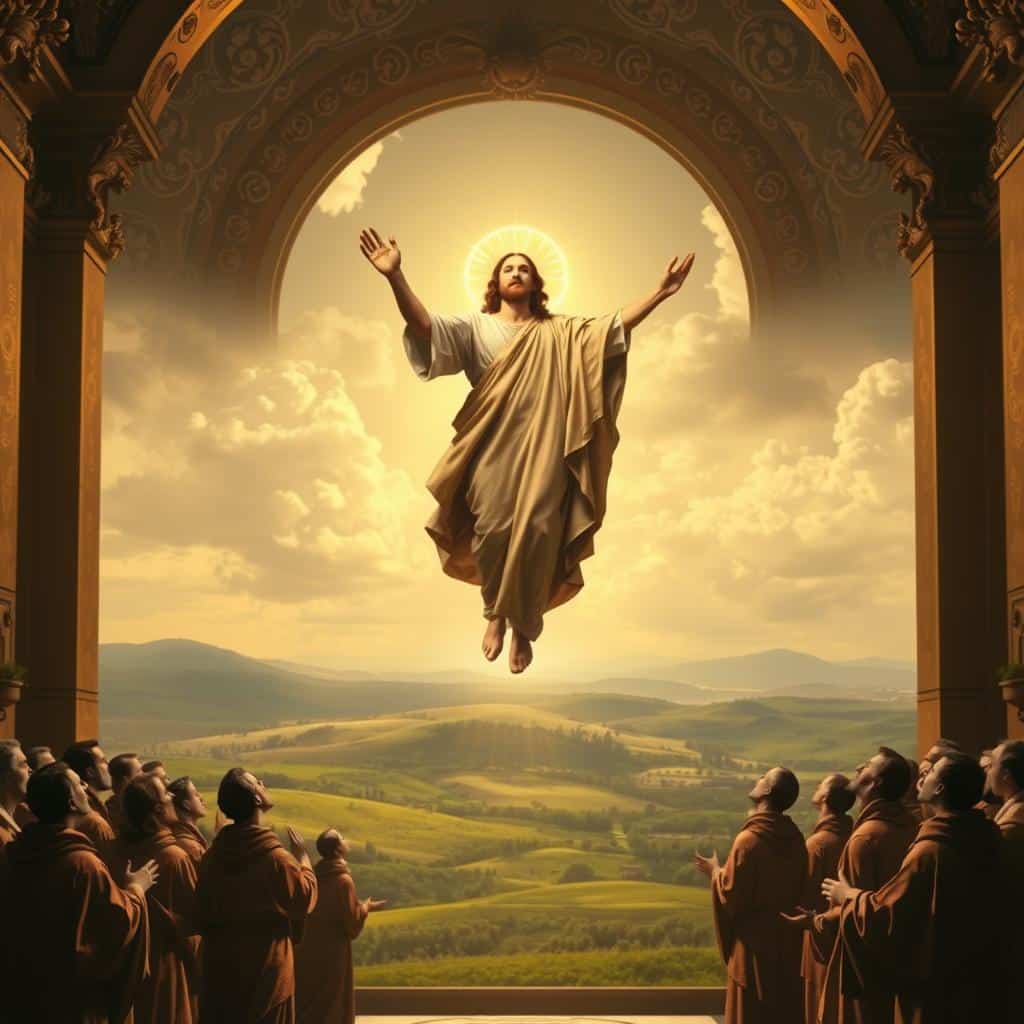
Famous Ascension Artwork
Many famous artists have depicted the Ascension. For example, Andrea Mantegna’s “Ascension” shows a detailed and dramatic scene. It highlights Christ’s glory. John Singleton Copley’s work focuses on the emotional and spiritual impact on the disciples.
Symbolism in Ascension Imagery
The Ascension is full of symbols. The cloud, angels, and Christ’s posture all carry deep meanings. The cloud represents the divine and the mystery of the Ascension. Angels are heavenly messengers. Christ’s rise symbolizes his victory and return to the Father.
Contemporary Artistic Interpretations
In today’s art, the Ascension still inspires artists. They often see it in new ways, using abstract styles or adding cultural touches. As one artist said, “The Ascension is not just a historical event but a living reality that continues to inspire and challenge us today.”
“The Ascension is a mystery that invites us to contemplate the glory of Christ and our own calling as disciples.”
The Ascension in Church Fathers’ Writings
The early Church Fathers gave deep insights into the Ascension. They shaped Christian theology. Their views on this key event still shape our understanding today.
Patristic Interpretations
The Church Fathers saw the Ascension as a key moment. It marked Christ’s return to heaven and his ongoing help for us. St. Augustine and St. Irenaeus wrote a lot about it. They showed its importance for our faith.
- St. Augustine said the Ascension showed Christ’s victory over sin and death.
- St. Irenaeus linked the Ascension to the unity of the Church. He saw it as a fulfillment of Old Testament prophecies.
Development of Ascension Theology
The Church Fathers’ writings helped grow Ascension theology. They explored its meaning for our salvation and the Church. Their work set the stage for later theological ideas.
- The Ascension was seen as a step for the Holy Spirit to come.
- It showed Christ’s role as a bridge between God and us.
Relevance of Ancient Wisdom for Today’s Believers
The wisdom of the Church Fathers is still valuable today. It helps us understand the Ascension and its role in our lives. Their insights encourage a deeper faith and a greater appreciation for Christ’s mission.
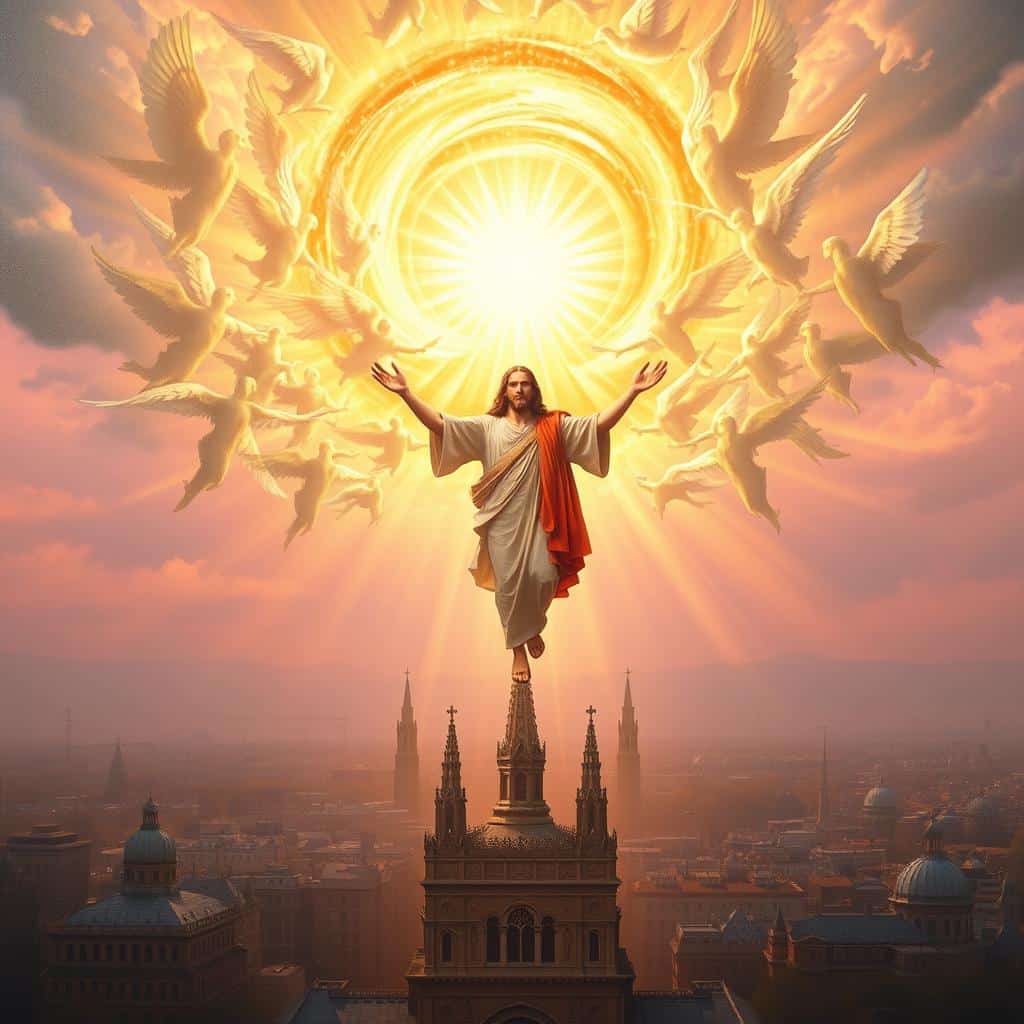
Living the Message of the Ascension in American Catholic Life
The Ascension message is deeply meaningful in American Catholic life. It calls for spiritual renewal. Catholics across the United States celebrate this feast, reminding them to live their faith every day.
Personal Spiritual Application
The Ascension invites Catholics to think about their relationship with Christ. It shows how their choices reflect their faith. Pope Francis says, “The Ascension is a call to hope, a call to be transformed, a call to be conformed to the Lord Jesus.” This transformation is a journey of spiritual growth, guided by prayer and reflection.
Community Dimensions
The Ascension also emphasizes community. It encourages Catholics to support each other in their faith. Through communal worship and service, Catholics can embody the message of the Ascension.
Witnessing in a Secular World
In a secular world, Catholics must be witnesses to the Risen Christ. This means living their faith at work, in their neighborhoods, and in the community.
“You will be my witnesses in Jerusalem, and in all Judea and Samaria, and to the ends of the earth.” (Acts 1:8)
Practical Ways to Embody Ascension Hope
- Engage in daily prayer and reflection
- Participate in community service projects
- Share the Gospel with others through word and deed

By following these practices, American Catholics can live the Ascension message. They can bring hope and light to a world in need.
Embracing Our Call as Witnesses to the Risen and Ascended Lord
The Ascension of the Lord is a key moment in Christian faith. It highlights our duty to share the story of the risen and ascended Lord. As part of the Catholic Church, we have this important task.
Being a witness means living our faith every day. We share the message of salvation and show love, compassion, and forgiveness. This call is for all Christians, not just the apostles.
Thinking about the Ascension reminds us of Christ’s journey back to heaven. It also reminds us of his promise to return. This hope keeps us going as we share the Good News.
By embracing our role as witnesses, we grow closer to the Christian community. We fulfill our duty in the Catholic Church. Let’s keep sharing the Good News, inspired by the risen Lord and guided by the Holy Spirit.
